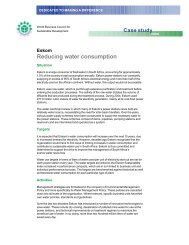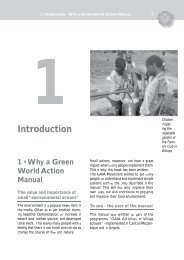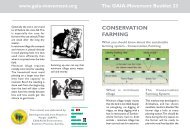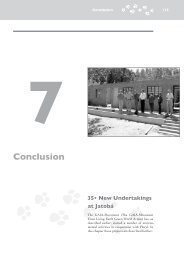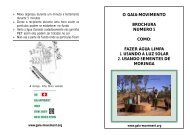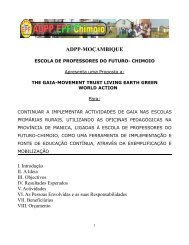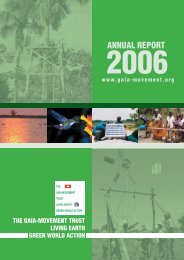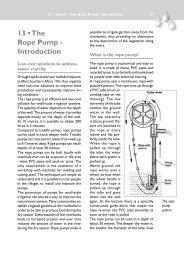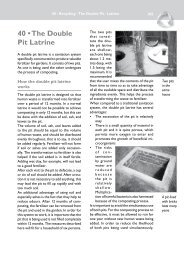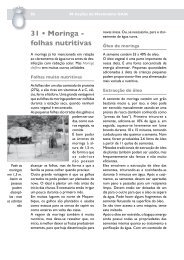Annual Report 2009 - The Gaia-Movement
Annual Report 2009 - The Gaia-Movement
Annual Report 2009 - The Gaia-Movement
You also want an ePaper? Increase the reach of your titles
YUMPU automatically turns print PDFs into web optimized ePapers that Google loves.
THE<br />
GAIA-MOVEMENT<br />
TRUST<br />
LIVING EARTH<br />
GREEN WORLD ACTION<br />
THE GAIA-MOVEMENT TRUST<br />
LIVING EARTH<br />
GREEN WORLD ACTION<br />
ANNUAL REPORT<br />
<strong>2009</strong><br />
www.gaia-movement.org
<strong>Annual</strong> <strong>Report</strong> <strong>2009</strong><br />
ANNUAL REPORT <strong>2009</strong><br />
Our Planet and its wealth of life is under threat by Global Warming and Climate<br />
Change. This will especially affect the poor parts of the world. <strong>The</strong> GAIA-<strong>Movement</strong><br />
sees it as one of its greatest tasks to support projects that improve livelihoods and<br />
enable people to cope with the impacts of these changes, while at the same time<br />
benefiting their local environment. <strong>The</strong> projects supported in 2008-9 by the Swiss<br />
registered non-profit association, <strong>The</strong> GAIA-<strong>Movement</strong>, are located in six different<br />
countries in Asia and Southern Africa. <strong>The</strong> actions have reached school children,<br />
teachers, farmers and other groups of people, and increased their awareness<br />
of the importance of their environment and how to preserve it. Affordable model<br />
systems have been established that show how improving the environment can be<br />
combined with a continued improvement of people’s daily life.<br />
<strong>The</strong> GAIA-<strong>Movement</strong> has created the projects, assisted and supervised the implementing<br />
parties, as well as secured the funding for the projects. A major effort<br />
has also been to raise funds for more environmental projects.<br />
<strong>The</strong> projects and activities have been made possible through donations to <strong>The</strong><br />
GAIA-<strong>Movement</strong>, direct funding from partners, monetary and in kind donations<br />
by the dedicated implementers of the projects, and assistance from many volunteers.<br />
Of special importance have been the royalty payments from Green World Recycling<br />
Ltd., without which <strong>The</strong> GAIA-<strong>Movement</strong> would not have been able to run<br />
and develop its activities. (see more pg. 15)<br />
<strong>The</strong> GAIA-<strong>Movement</strong> wishes to thank you all for your contribution to make the<br />
environmental projects and activities possible.<br />
On behalf of <strong>The</strong> GAIA-<strong>Movement</strong> Trust Living Earth Green World Action,<br />
Elsebeth Soendergaard,<br />
Chairperson<br />
<strong>The</strong> GAIA-<strong>Movement</strong>,<br />
International Environment House II,<br />
Chemin de Balexert 9,<br />
CH 1219 Châtelaine,<br />
Switzerland<br />
THE<br />
GAIA-MOVEMENT<br />
TRUST<br />
LIVING EARTH<br />
GREEN WORLD ACTION<br />
Tel: +41 22 548 0415<br />
E-Fax: +1 801 640 1687<br />
info@gaia-movement.org<br />
www.gaia-movement.org<br />
Postal account: 17-478317-4<br />
GAIA-MOVEMENT |<br />
2
Table of Contents<br />
Integrated Water Management<br />
p. 4 Community Water Management<br />
p. 5 “Integrated Water & Sanitation,<br />
Southern Province”<br />
p. 6 “Green Pumps”, Zimbabwe<br />
p. 7 “Pumps for Life”, Northern Province,<br />
Zambia<br />
p. 8 “TAZAMO” (Tanzania, Zambia, Mozambique)<br />
project<br />
p. 9 “Improving Environment and Living<br />
Conditions in Peri-Urban Kinshasa”,<br />
DRC<br />
Village Community Projects<br />
p. 10 “Harit Sankalp - Green Action, a<br />
GAIA Project”<br />
p. 11 “Trees for Life”, Soyo Province, Angola<br />
p. 12 “Eco-Service Center, Tamil Nadu”,<br />
India<br />
ANNUAL REPORT <strong>2009</strong><br />
Renewable Energy Projects<br />
p. 13 “Community Generated Power”, Zambia<br />
p. 14 “Jatropha oil for local development”,<br />
Mozambique<br />
Smaller projects funded by the GAIA-<strong>Movement</strong><br />
p. 15 “Solar Lamps to Mozambique”<br />
“Information on Global Warming and<br />
Second Hand Clothes”, Russia<br />
“Recycling of Textile Fibres”, Austria<br />
“Increasing Crop Production”, Itoculo,<br />
Mozambique<br />
About <strong>The</strong> GAIA-<strong>Movement</strong><br />
p. 16 R&D Activities<br />
Information Activities<br />
Funding of the GAIA-<strong>Movement</strong><br />
GAIA-MOVEMENT |<br />
3
Community Water Management<br />
Community Water Management Projects<br />
WHY THE PROJECTS ARE NEEDED<br />
With the increasingly more irregular weather patterns it<br />
becomes more and more urgent to be able to manage<br />
and preserve the local water resources. Scientists are<br />
not in doubt that Africa and India are among the regions<br />
that be worst affected by climate changes caused by<br />
global warming. In both regions there will be longer<br />
drought periods and more frequent and severe floods.<br />
Many more people - and many other of our fellow living<br />
organisms - will experience water stress and water<br />
scarcity.<br />
Groundwater tables are already falling more and more,<br />
and the number of wells that have no water at the end of<br />
the dry season continue to increase.<br />
Vegetation in water catchment areas is being cut down,<br />
and rivers are dry for longer periods. <strong>The</strong> reduced tree<br />
cover and soil erosion lead to loss of fertile topsoil and<br />
more destructive floods.<br />
<strong>The</strong>re are, however, many things that communities can<br />
do to safeguard and improve their local water resources.<br />
It is therefore essential to assist them to do so.<br />
<strong>The</strong> water can be used for household uses and it can be used<br />
for garden irrigation.<br />
ANNUAL REPORT <strong>2009</strong><br />
Rope pumps can be produced in simple workshops. Villagers<br />
can install and maintain them with locally available materials.<br />
PUMP PRODUCTION<br />
15 units for production of rope pumps have been<br />
established as a result of GAIA supported projects:<br />
• Mozambique: Chimoio, Itoculo and Bilibiza<br />
• Zambia: Monze, Chibombo, Kalomo, Choma, Kaoma,<br />
Kapiri, Mpika and Nchelenge<br />
• Zimbabwe: Shamva<br />
• Angola: Cabinda<br />
• Malawi: Chiradzulu<br />
• India: Tamil Nadu<br />
Several experts connected to Arrakis/Connect<br />
International/Practica Foundation, have greatly<br />
assisted by continuously improving the models and the<br />
production methods. <strong>The</strong> workshops are now able to<br />
produce quality rope pumps at affordable prices.<br />
GAIA-MOVEMENT |<br />
4
Community Water Management<br />
“Integrated Community Water and Sanitation in Southern Province, Zambia”<br />
ACHIEVEMENTS IN 2008-9<br />
• 85 wells rehabilitated, 66 new wells and 12 boreholes<br />
completed – all provided with rope pumps<br />
• 198 rope pumps produced<br />
• 24 groundwater recharge systems have improved<br />
water levels in the wells benefiting 170 households.<br />
• <strong>The</strong> Monze earth dam (weir dam) provides water for<br />
150 households and their livestock during drought<br />
periods,<br />
• 130 latrine masons trained<br />
• 2,886 families have built improved pit latrines.<br />
• 121,000 people have been reached with campaigns<br />
on basic sanitation and hygiene.<br />
• 19,234 people have obtained access to safe water<br />
from new and restored water points.<br />
• 49 farmers have received rope pumps as revolving<br />
loans.<br />
• 100 community agricultural committees trained in<br />
water management<br />
• 10,327 farmers using systems to reduce erosion, and<br />
155 km of contours established<br />
• 212,000 trees planted<br />
• 192 stove masons trained and 3,850 families have<br />
built firewood saving stoves<br />
10,000 farmers are now using systems to manage water – such<br />
as trenches which are then filled with compost material.<br />
ANNUAL REPORT <strong>2009</strong><br />
121,000 people have been trained to improve hygiene and<br />
sanitation practices – such as using improved dish racks.<br />
CONCLUSION<br />
<strong>The</strong> project has had a big influence in the area by<br />
introducing and spreading simple and affordable<br />
systems to improve sanitation and access to safe water.<br />
A large number of people have adopted improved<br />
practices in relation to sanitation, water management<br />
and environment.<br />
FACTS<br />
• <strong>The</strong> project started in April 2007 and ended in April<br />
<strong>2009</strong><br />
• Implemented by the DAPP in Zambia project - Child<br />
Aid and Environment, Southern Province<br />
• <strong>The</strong> EU Water Facility is the main funding source.<br />
<strong>The</strong> GAIA-<strong>Movement</strong> co-funds the project with direct<br />
funding and contribution of environmental expertise.<br />
DAPP Zambia as well as community members also<br />
provide co-funding in the form of labour.<br />
GAIA-MOVEMENT |<br />
5
Community Water Management<br />
“Green Pumps - Sustaining Women Livelihoods and Water Resources”<br />
ACHIEVEMENTS IN 2008-9<br />
• 20 groups of women farmers - 200 women - have<br />
established wells, which have been lined and covered<br />
to protect against contamination. 20 women groups<br />
have been formed.<br />
• 20 wells have been equipped with rope pumps. On<br />
average each pump benefits 240 people.<br />
• 10 pump menders have been trained to maintain and<br />
install rope pumps.<br />
• 9 garden groups have managed to sell their garden<br />
produce and have expanded their gardens.<br />
• 18 kinds of vegetables are produced in the gardens<br />
• 20,000 trees have been planted by the communities<br />
in Shamva and Bindura. On average a group<br />
produces and plants 500 eucalyptus, 150 jatropha<br />
trees, 150 fruit trees, 100 moringa trees and 100<br />
animal fodder plants.<br />
• All group members and 40 village development<br />
committee members have been trained in horticultural<br />
production and environmental issues.<br />
• 200 firewood saving stoves have been built.<br />
• 7 garden days held for all community members.<br />
• A 15 minute videofilm about the project has been<br />
produced.<br />
<strong>The</strong> food gardens have had a huge impact during the periods of<br />
droughts, lack of inputs and economic problems in the country.<br />
ANNUAL REPORT <strong>2009</strong><br />
20 women self help groups have established irrigated vegetable<br />
gardens. <strong>The</strong> pumps also provide household water.<br />
CONCLUSION<br />
20 vegetable gardens have been established in Shamva<br />
and Bindura, where the pumps provide water for both<br />
households and irrigation.<br />
<strong>The</strong> project has meant that 200 families have been<br />
able to produce sufficient food during a difficult period,<br />
and they have additionally inspired many others in their<br />
communities.<br />
FACTS<br />
• Green Pumps started in May 2007 and ended in May<br />
<strong>2009</strong>.<br />
• Implemented by the DAPP Zimbabwe project “From<br />
Communal to Commercial Farmer”.<br />
• Funded by <strong>The</strong> McKnight Foundation (USA) through<br />
<strong>The</strong> GAIA-<strong>Movement</strong>.<br />
GAIA-MOVEMENT |<br />
6
Community Water Management<br />
“Pumps for Life”, Northern Province, Zambia<br />
WHAT THE PROJECT DOES<br />
<strong>The</strong> project will assist 5,000 households organized<br />
in 250 Village Action Groups with technologies and<br />
training to improve access to safe water for household<br />
and irrigation purposes.<br />
50 water points will be established in the form of new<br />
and rehabilitated wells to function as model systems.<br />
50 Agricultural Committees will be trained to manage<br />
revolving funds, where rope pumps are given out as<br />
loans to farmers selected by the Committee. <strong>The</strong> farmers<br />
generate income from the vegetables they can produce<br />
and will be able to pay back the loan within 1-2 years.<br />
<strong>The</strong> Committee then selects a new farmer to receive a<br />
rope pump loan.<br />
ACHIEVEMENTS IN 2008-9<br />
• 35 Agricultural Committees in Mpika District have<br />
been trained.<br />
• 177 Village Action Groups are involved in the project,<br />
and so far 3,600 group members have been trained in<br />
sustainable and water efficient farming.<br />
• One rope pump workshop has been established.<br />
Hundreds of farmer will get pumps as revolving loans to provide<br />
water for profitable garden farming that can repay the loans.<br />
ANNUAL REPORT <strong>2009</strong><br />
20 village water technicians have been trained to install and<br />
maintain the rope pumps.<br />
• 20 rope pumps have been installed as demonstration<br />
models. <strong>The</strong> farmers will pay for these pumps by<br />
producing and distributing 1,000 tree seedlings.<br />
• 20 pumps have been sold through the system<br />
of revolving loans managed by the Agricultural<br />
Committees, and two pumps have been sold to<br />
private individuals.<br />
• 20 Pump Menders have been trained to install and<br />
maintain the pumps.<br />
• A field day has been held to demonstrate the pump<br />
system and garden production.<br />
FACTS<br />
• <strong>The</strong> Pumps for Life project started in May 2008 and<br />
will end in May 2011.<br />
• Implemented by DAPP (Development Aid from<br />
People to People) Zambia Child Aid in Mpika<br />
• <strong>The</strong> main funding comes from the British Waterloo<br />
Foundation with co-funding from <strong>The</strong> GAIA-<strong>Movement</strong><br />
through a donation from <strong>The</strong> GAIA-<strong>Movement</strong> Living<br />
Earth Green World Action USA, Inc.<br />
GAIA-MOVEMENT |<br />
7
Community Water Management<br />
TAZAMO (Tanzania, Zambia, Mozambique) Water & Sanitation Project<br />
ACHIEVEMENTS IN 2008-9 (Za+Mo)<br />
Zambia<br />
• 5 workshops to produce rope pumps have been<br />
established in Choma, Kaoma, Kapiri, Mpika and<br />
Nchelenge.<br />
• 51 new wells and 44 wells have been rehabilitated.<br />
Pumps have been installed in all of them.<br />
• 2,314 + 1,294 latrines built.<br />
• <strong>The</strong> rope pumps have been marketed at during<br />
Agricultural Shows in Lusaka, Livingstone and Ndola,<br />
and through local radio broadcasts.<br />
• 40,000 families reached with hygiene and sanitation<br />
education<br />
Mozambique<br />
• 90 rope pumps produced and installed on wells and<br />
boreholes in 2008, and 50 more by Aug. <strong>2009</strong>.<br />
• 4 bricklayers have made and sold 254 latrine slabs.<br />
• 7 teams of 2 drillers received more training, and 18<br />
new were trained.<br />
• 138 water technicians trained.<br />
• 22,800 families reached with hygiene and sanitation<br />
education, led by 207 Village Action Groups.<br />
Rope pump installation in Northern Mozambique. Thousands<br />
benefit from having safe water and spending less time to get it.<br />
ANNUAL REPORT <strong>2009</strong><br />
TAZAMO is reaching out to hundreds of thousands of people,<br />
including children, with water and sanitation messages.<br />
• 11,019 traditional latrines built (pit with slab of clay on<br />
logs)<br />
• 9,086 dish washing racks set up.<br />
• 10,206 garbage holes made.<br />
• 851 hand-washing systems set up.<br />
FACTS<br />
• <strong>The</strong> TAZAMO project started in Jan. 2006 and will<br />
end Dec. 2010<br />
• Implemented by several DAPP (Development Aid<br />
from People to People) Zambia Child Aid projects, by<br />
ADPP Mozambique Child Aid Itoculo and by Southern<br />
Highland Participatory Organization in Tanzania.<br />
Coordinated by the Dutch NGO Connect International.<br />
<strong>The</strong> GAIA-<strong>Movement</strong> contributes to coordination of<br />
activities in Zambia and Mozambique.<br />
• <strong>The</strong> main funding comes from the Dutch Government.<br />
Connect International raises funds from other Dutch<br />
donors. <strong>The</strong> implementing partners co-funds the<br />
project, as does <strong>The</strong> GAIA-<strong>Movement</strong> through royalty<br />
income from Green World Recycling Ltd. and through<br />
donations from <strong>The</strong> GAIA-<strong>Movement</strong> Living Earth<br />
Green World Action USA, Inc.<br />
GAIA-MOVEMENT |<br />
8
Community Development Projects<br />
“Improving Environment and Living Conditions in Peri-Urban Kinshasa”, DRC<br />
WHAT THE PROJECT DOES<br />
<strong>The</strong> project targets the peri-urban areas around<br />
Kinshasa, the capital of DR Congo, where the<br />
relative dense population and the lack of any public<br />
infrastructures offer a serious threat against the<br />
environment, which at the same time provides the main<br />
source of income.<br />
<strong>The</strong> project targets issues such as treeplanting, firewood<br />
saving stoves, erosion control, latrine construction, solar<br />
energy and conservation farming.<br />
ACHIEVEMENTS IN 2008-9<br />
• 440 firewood saving stoves benefiting 440 families<br />
have been established<br />
• 2 solar panels installed<br />
• 8 latrines have been constructed<br />
• 3.000 families organized in Family Action Groups<br />
have benefited from training in improvement their<br />
local environment<br />
• 8 community cleaning actions have been held in the<br />
communities<br />
• 3 areas affected by erosion have been secured.<br />
Local officials drinking water from a source that has been turned<br />
into a source of safe drinking water by the project.<br />
ANNUAL REPORT <strong>2009</strong><br />
<strong>The</strong> 3,000 families in the areas close to Kinshasa benefit greatly<br />
from the project activities. Here from a firewood saving stove.<br />
• 200 garden farmers organized in 8 groups have<br />
been trained in horticultural techniques, composting,<br />
storage of food crops, the importance of trees and a<br />
healthy environment, and have been given seeds and<br />
tools<br />
• 1 nursery has been set up and 5,000 tree seedlings<br />
are currently under production<br />
• 1 water source has been established, serving 50<br />
households<br />
• 1 district development committee has been<br />
established<br />
FACTS<br />
• <strong>The</strong> project started in December 2008 and will end in<br />
December <strong>2009</strong><br />
• Implemented by Humana People to People (HPP) –<br />
Congo<br />
• Funded by <strong>The</strong> GAIA-<strong>Movement</strong> through royalty<br />
income from Green World Recycling Ltd. and through<br />
donations from <strong>The</strong> GAIA-<strong>Movement</strong> Living Earth<br />
Green World Action USA, Inc.<br />
GAIA-MOVEMENT |<br />
9
Community Development Projects<br />
“Harit Sankalp - Green Action, a GAIA Project”, India<br />
MAIN ACHIEVEMENTS<br />
• 85 households have rainwater collecting systems<br />
• 1,527 kitchen gardens are using waste water for<br />
irrigation. 345 have installed drip or sprinkler irrigation.<br />
• 869 vermiculture units established (earthworms<br />
producing compost)<br />
• 4,262 households with at least 5 trees planted<br />
• 1,314 households now have smokeless kitchens by<br />
using firewood saving stoves (chulhas)<br />
• 1,110 farmers using sustainable farming practices on<br />
model plot of 0.25 ha<br />
• 1,125 farmers practicing organic farming on some<br />
parts of their land<br />
• 936 households have built toilets<br />
• 1,542 households have systems to separate animals<br />
from people<br />
• 6 villages have made groundwater recharge systems<br />
• 6 villages have established road drainage systems<br />
• 9 villages have set up functioning systems for treating<br />
waste and recycling items<br />
• 1 village has planted Children’s Forest for Future of<br />
10,000 trees, and 9 villages have model gardens full<br />
of trees covering 40 ha<br />
Water saving systems, such as drip irrigation, are crucial in<br />
Rajasthan, where water tables fall at least 1 m/year.<br />
ANNUAL REPORT <strong>2009</strong><br />
Farmers have made jatropha nurseries and plant jatropha<br />
fences around their fields to give seeds for biofuel.<br />
CONCLUSION<br />
This project is a pilot project with the large goal of<br />
mobilizing whole communities to become “green”.<br />
<strong>The</strong> project has on a large scale mobilized community<br />
members to change practices that influencing the<br />
environment.<br />
<strong>The</strong> goal of having at least 1,500 households using<br />
sustainable practices has been reached.<br />
FACTS<br />
• <strong>The</strong> first phase started in June 2005 and ended June<br />
2007. <strong>The</strong> second phase extended this for two more<br />
years and ended in June <strong>2009</strong>.<br />
• Implemented in Rajasthan by Humana People to<br />
People India.<br />
• <strong>The</strong> GAIA-<strong>Movement</strong> has funded Harit Sankalp with<br />
donations from <strong>The</strong> GAIA-<strong>Movement</strong> Living Earth<br />
Green World Action USA, Inc. as well as a donation<br />
from Green World Recycling, Ltd.<br />
GAIA-MOVEMENT |<br />
10
Community Development Projects<br />
“Trees for Life”, Soyo Province, Angola<br />
WHAT THE PROJECT DOES<br />
<strong>The</strong> projects has the subtitle:<br />
”Improving Food Security, Income and Management of<br />
Natural Resources among Women Farmers”.<br />
<strong>The</strong> project improves food security in 30 communities in<br />
Soyo Municipality, through sustainable management of<br />
forest and other natural resources, through changes in<br />
agricultural practices and through improved tree cover in<br />
the project area.<br />
<strong>The</strong> project promotes diversification, nutritious crops,<br />
low cost irrigation and improved processing practices.<br />
Access to water for household uses is also improved.<br />
ACHIEVEMENTS SINCE START<br />
• 30 garden farmers clubs have been established with<br />
1.248 members.<br />
• 15 teacher trainees have been trained in<br />
environmental issues<br />
• <strong>The</strong> club members are being trained in literacy and<br />
numeracy.<br />
• 5 new wells have been dug and existing wells have<br />
been repaired.<br />
10,000 moringa trees have been produced in such nurseries<br />
and now provide nutritious leaves in 25 communities.<br />
ANNUAL REPORT <strong>2009</strong><br />
<strong>The</strong> 1,250 members, mainly women, have been trained in<br />
sustainable practices, such as solar drying of fish and leaves.<br />
• 9,300 seedlings of jatropha, moringa, acacias, and<br />
many different fruit trees: mango, papaya, lime,<br />
orange, avocado, cashew and palm oil are being<br />
produced in the 30 club nurseries.<br />
• 10,000 moringa trees planted.<br />
• 100 families have built firewood saving stoves<br />
• 18 community cleaning actions have been held.<br />
• 20 clubs have been trained in bamboo cultivation and<br />
have started production.<br />
• 16 clubs have established model gardens<br />
• <strong>The</strong> FC members have been trained in drying of fish<br />
and of moringa leaves.<br />
FACTS<br />
• <strong>The</strong> project started in February 2008 and will end in<br />
February 2010<br />
• Implemented by Ajuda de Desenvolvimento de Povo<br />
para Povo (ADPP), Angola<br />
• Funded mainly by the EU Food Facility Programme<br />
and co-funded by <strong>The</strong> GAIA-<strong>Movement</strong> through a<br />
donation from <strong>The</strong> GAIA-<strong>Movement</strong> Living Earth<br />
Green World Action USA, Inc.<br />
GAIA-MOVEMENT |<br />
11
Community Development Projects<br />
“Eco-Service Center, Tamil Nadu”, India<br />
WHAT THE PROJECT DOES<br />
<strong>The</strong> project has established the Eco-service<br />
Centre where a number of sustainable systems are<br />
demonstrated and targeted– such as the issues of<br />
treeplanting, firewood saving stoves, erosion control,<br />
latrine construction, solar and other renewable energy<br />
systems, sustainable farming, affordable and waterefficient<br />
irrigation, vermiculture, efficient micro-organisms<br />
and in general environmentally sustainable practices.<br />
ACHIEVEMENTS SINCE START<br />
• 5 farmers clubs established<br />
• 5 Women Self Help Groups have started 5 EM units,<br />
2 organic pesticide units and 10 Kitchen gardens.<br />
• 5 Children’s Clubs started and carried out 28 actions<br />
on sanitation, nutrition<br />
• 2 Open Sundays held at the Eco-Service Center to<br />
give awareness about global warming and sanitation<br />
• 2 small films produced and available on Youtube. One<br />
about biogas made from food waste and the other<br />
about skill training of Development Instructors.<br />
• 18 Development Instructors trained in sustainable<br />
Youth club members visiting the Eco-Service Centre, and told<br />
why to use drip irrigation systems.<br />
ANNUAL REPORT <strong>2009</strong><br />
Preparing leaves for production of EM – Efficient Microorganisms<br />
– to improve crop yields and reduce diseases.<br />
development practices<br />
• 1 rabbit production started as income generation for<br />
the Centre.<br />
• 1 biogas system has been set up at the Centre,<br />
producing gas for 2 hours of cooking.<br />
• 2 eco-sanitation toilets have been built at the Centre<br />
• Achieved to get a donation for 10 rope pumps, which<br />
the centre will build and set up in five villages.<br />
• Started income generation by making films for other<br />
NGOs.<br />
FACTS<br />
• Started in March <strong>2009</strong> and will end in December<br />
<strong>2009</strong>.<br />
• Implemented in Tamil Nadu by Humana People to<br />
People India.<br />
• Funded by <strong>The</strong> GAIA-<strong>Movement</strong> through royalty<br />
income from Green World Recycling Ltd. and through<br />
donations from <strong>The</strong> GAIA-<strong>Movement</strong> Living Earth<br />
Green World Action USA, Inc.<br />
GAIA-MOVEMENT |<br />
12
Renewable Energy Projects<br />
“Community Generated Power”, Zambia<br />
ACHIEVEMENTS SINCE START<br />
• 80,000 jatrophas have been planted by 800 farmers –<br />
both from seeds and from cuttings<br />
• 400 farmers have been trained in soap production<br />
and use of jatropha oil for lamps<br />
• 1 oil press and 1 biodiesel unit set up at DAPP’s<br />
Children’s Town.<br />
• 1400 liters of biodiesel have been produced from<br />
jatropha, cottonseed and waste oil at DAPP’s unit at<br />
Children’s Town and used in 20 tractors, grinding mills<br />
and vehicles in the project area.<br />
• 3 endurance tests of 512 hours have been conducted<br />
at Delhi College of Engineering on a direct injection<br />
diesel engine, and on test of 512 hours on an indirect<br />
injection engine in order to find a safe, viable system.<br />
• 2 diesel engines in Zambia have run with dual fuel<br />
systems for 500 hours on jatropha oil.<br />
• 1 conference held to spread the project approaches<br />
to local and governmental authorities, the Zambia<br />
biofuel association, other NGOs and entrepreneurs.<br />
• 1,200 guests informed about the systems at the<br />
Lusaka Agricultural Show.<br />
• 2,000 pamphlets on jatropha growing distributed.<br />
Biodiesel is produced from jatropha oil after it has been pressed<br />
from the seeds at the unit in DAPP’s Children’s Town.<br />
ANNUAL REPORT <strong>2009</strong><br />
Conference explaining how the project has started local biofuel<br />
production based on the jatropha plants grown by 800 farmers.<br />
CONCLUSION<br />
<strong>The</strong>re is great interest among farmers for the system of<br />
having local energy systems run on oil from their crops.<br />
<strong>The</strong>re are two ways to use the oil. One is to produce<br />
biodiesel. This can be done locally but requires some<br />
skills, equipment and certain chemicals.<br />
<strong>The</strong> other option is to use the jatropha oil directly as fuel<br />
in engines. <strong>The</strong> tests in India have shown that this can<br />
be done safely with indirect injection engines (old Lister<br />
types). <strong>The</strong> final test of the more modern engines are<br />
very promising, and further tests are being conducted to<br />
develop this method.<br />
FACTS<br />
• <strong>The</strong> project started in April 2008 and ended in<br />
October <strong>2009</strong><br />
• Implemented by <strong>The</strong> GAIA <strong>Movement</strong> and DAPP<br />
Zambia<br />
• Funded by GVEP Int. (Global Village Energy<br />
Partnership) with USAID funds to the GAIA-<strong>Movement</strong><br />
and co-funded by Green World Recycling Ltd.<br />
GAIA-MOVEMENT |<br />
13
Renewable Energy Projects<br />
“Jatropha oil for local development in Mozambique”<br />
WHAT THE PROJECT DOES<br />
<strong>The</strong> project has started local production of Jatropha<br />
seeds and will develop a local market for the oil. 250<br />
ha of land will be cultivated with Jatropha after 3 years.<br />
Another important component of the project is to build<br />
capacity among the local small farmers in general by<br />
setting up 25 farmers clubs where the members are<br />
trained in sustainable farming practices.<br />
Project technicians are trained to process the oil and to<br />
adapt 25 stationary diesel engines so that they can run<br />
on the plant oil. <strong>The</strong> oil will also be used as lamp oil and<br />
for soap production.<br />
ACHIEVEMENTS SINCE START<br />
• About 250,000 jatrophas planted and growing since<br />
the start of 2007, most of these as fences.<br />
• 36 Farmers Clubs have been established and the<br />
club committees trained.<br />
• 22 irrigated gardens and jatropha nurseries<br />
established.<br />
• 5 tons of jatropha seeds sold by farmers and ready to<br />
be pressed.<br />
Some stationary diesel engines can easily be adapted to run<br />
mainly on plant oil, if they are started and shut down on diesel.<br />
ANNUAL REPORT <strong>2009</strong><br />
<strong>The</strong> project promotes jatropha fences such as this one, which<br />
keeps wild animals out – and does not reduce food production.<br />
• Bilibiza Biofuel Center established with a project<br />
technician, 2 oil presses and a generator adapted to<br />
run on plant oil.<br />
• A number of trials have been started to determine the<br />
best planting distance and pruning systems in the<br />
fences.<br />
• A number of high ranking officials have visited the<br />
centre and want to support the activities.<br />
FACTS<br />
• Started in January 2007. <strong>The</strong> project will end in<br />
December 2010<br />
• Implemented by the ADPP Moçambique projects -<br />
Farmer’s Club (FC) Bilibiza.<br />
• Funded by various Dutch organizations - Stichting<br />
HIVOS, Stichting Doen and Solidaridad - through<br />
FACT Foundation (Fuels from Agriculture in<br />
Communal Technology). <strong>The</strong> GAIA-<strong>Movement</strong><br />
co-funds the project through donations from <strong>The</strong><br />
GAIA-<strong>Movement</strong> Living Earth Green World Action<br />
USA, Inc.<br />
GAIA-MOVEMENT |<br />
14
Smaller projects funded by the<br />
GAIA-<strong>Movement</strong><br />
“Solar Lamps to Mozambique”<br />
Checking solar lanterns. 2,000 units are sold through<br />
the sales network for second-hand clothes of ADPP<br />
Mozambique, and through commercial entities. Many<br />
Mozambicans can pay for the cost of a lantern within a<br />
year due to reduced expenses on candles or kerosene.<br />
“Info on Global Warming, Russia”<br />
!"#$%&'$#()%*+,$&(-%./%0$*1&,&-(2%&3#$4'"&<br />
,52"/(,"%+*1&*#%67./(-&$82"9$-:&8%9&-";(
THE GAIA-MOVEMENT TRUST<br />
LIVING EARTH<br />
GREEN WORLD ACTION<br />
ANNUAL REPORT <strong>2009</strong><br />
INFORMATION<br />
FUNDING RESEARCH & DEVELOPMENT<br />
Green World Recycling Ltd. in the UK pays royalties<br />
for using <strong>The</strong> GAIA <strong>Movement</strong>’s logo in its business<br />
to collect and sell used clothing. This enables people<br />
to support protection of the environment twice: by<br />
recycling their used clothes - and therefore reducing the<br />
need for landfills or emissions of greenhouse gasses -<br />
and by supporting environmental projects and activities.<br />
Production of a 15 minute video of the<br />
“Green Pumps” project in Zimbabwe,<br />
describing how the women groups have<br />
benefited from their garden farming.<br />
<strong>The</strong> Eco-Service Centre in Tamil Nadu<br />
has also produced small films on the<br />
use of rope pumps, construction of a<br />
simple biogas system and eco-sanitation<br />
toilets. Placed on Youtube (search for<br />
udhayananraja - the Project Leader).<br />
Other examples of information activities<br />
are small publications in English and<br />
Portuguese with the titles: “How Must<br />
Africa Adapt to Climate Change”, “Regreening<br />
Niger”, “Restoring Watertables<br />
in India” and “Cotton Farmed Sustainably,<br />
South Asia” .<br />
This work has partly been funded through<br />
donations from <strong>The</strong> GAIA-<strong>Movement</strong><br />
Living Earth Green World Action USA, Inc.<br />
Presenting results and lessons learned of the<br />
Zambian biofuel project in Washington together with<br />
other projects funded by the World Bank.<br />
R&D has also been to raise funds for projects with<br />
environmental activities: “Green Pumps”, Malawi,<br />
“Biofuels for Local Development”, Guinea Bissau and<br />
“Training Farmers for Green Action”, Mozambique.<br />
GAIA-MOVEMENT |<br />
16



